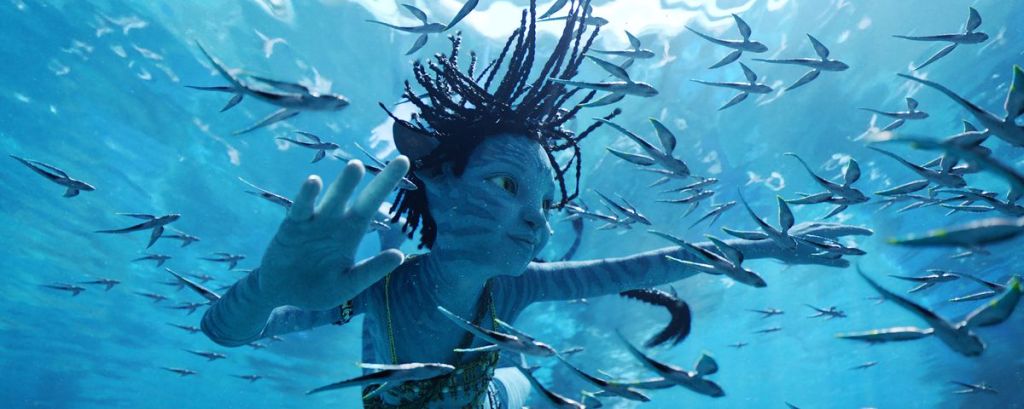A few years ago, someone on Twitter brought up the fact that Avatar, despite being a massive hit, left little to no cultural imprint on American pop culture. I can’t speak for the rest of the world, but after December 2009, all I ever heard about the movie was that the precious material on alien planet Pandora was called “unobtanium,” and that the script was a lazy ripoff of Pocahontas. Those reviews must have been the first time I read the phrase “white savior narrative,” relatively late for a junior in high school. But beyond that, none of Avatar’s characters, story, themes, concepts or images have broken through into general consciousness. It’s the most obscure success of all time.
How did a movie make so much money and leave so little behind?
The real enduring legacy of Avatar has nothing to do with the movie itself, but the way it was exhibited: James Cameron’s film kickstarted the era of digital projection, and the 2010s were the decade that celluloid was replaced by the DCP (“Digital Cinema Package”) as a means to produce and exhibit movies. Multiplexes, specialty chains, and arthouses fired their projectionists and threw away their 35mm film projectors, and by 2012, Hollywood stopped striking prints of new releases — and by then, James Cameron was nowhere to be found.
Working on a sequel? Presumably.
Thirteen years later, Avatar: The Way of Water has been released. I still haven’t seen the first one, and I went into this movie knowing little and expecting nothing. I got less than that. What I saw on Thursday afternoon made me sad and sick, as if I had bought a ticket to a snuff film or a donkey show.
In the lead-up to The Way of Water’s release, Cameron has given dozens of interviews where he marvels at how often he forgets that what he’s making contains “zero photography.” In his own words, there’s nothing real here. No problem, per se; cartoons have existed for over a century, and Pixar proved in 1995 with Toy Story that you can make an emotionally compelling and substantive film using only computer generated images.
So why did seeing this film feel like medieval torture?
The movie wastes little time at the beginning, with a brief summary of what happened once the Na’vi successfully sent home the humans looking for their unobtanium (Christ…). Jake Sully, played by Sam Worthington, is a soldier sent to Pandora via Na’vi “avatar” who decided to stick around and become a God on Pandora. When The Way of Water starts, he’s having a great time with his Pandoran wife Neytiri, played by Zoe Saldaña, and Na’vi children Neteyam, Lo’ak, Kiri, and Tuktirey, along with a human boy named Spider. Never underestimate the power and patience of the US military: after being mostly kicked off of Pandora, they’re back for more, eager to colonize and hopefully annihilate the coward traitor Jake Sully. Stephen Lang is back as Colonel Quatrich, killed but still able to inhabit a Na’vi avatar via… some kind of hard drive, circa 2164.
“If you’re watching this, Quatrich, well… that means my ticket must’ve been punched.” The disparity between hack dialogue like this and the CGI in this movie renders it totally inert, a film that has nothing to grab onto and virtually no connection to cinema as we know it.
The real analogue for the Avatar movies are video games, and if you didn’t grow up with a Nintendo 64 or PlayStation, this movie might impress you. It may even enthrall you and make you depressed in a different way than me: the only other thing I remember about the release of the first Avatar were the not-insignificant number of adults who fell into a deep depression after seeing the movie: people who were so amazed by what they saw that the real world just didn’t compare.
I also just can’t get over how atrociously ugly the Na’vi are, along with all of the other creatures on Pandora. It’s worse than Shrek. These characters are so repulsive that I was waiting for them to get wiped out. As for the reef people of Metkayina, and the wonderful world of water they inhabit, I couldn’t care less. I’d rather watch footage of actual water.
Avatar: The Way of Water is a three-hour-plus cutscene from a video game that you can’t play. It might be “immersive” if you’ve never played Final Fantasy. If you want to watch water, check out John Milius’s 1978 surfing epic Big Wednesday. Nothing in Cameron’s film can compare to Big Wednesday’s slow motion waves.
Really, what is the point of rendering a fake world so “realistically”? All of this time, money, and creative energy devoted to something less than useless, a “film” that barely qualifies as such, one that’s closer to a screensaver than Cameron’s own Titanic or Terminator. It’s especially frustrating because Cameron is a good filmmaker who has shaped the pop culture zeitgeist several times; besides their indelible images, this man made movies that gave us “I’ll be back,” “Paint me like one of your French girls” and “Get away from her, you bitch!” Futuristic technology has featured in nearly all of his films, but always as it related to human beings and universal emotions.
A critical problem with Avatar is how, for example, the water can ripple “just right” while the story, structure and dialogue could be ripped from any comic book or B-movie. This isn’t an aesthetic choice, just pure laziness; Cameron isn’t that incompetent, but he’s certainly delusional. I can only imagine what billions of dollars, that level of success and access to state of the art marine technology can do to a nerd like that. What I see is a director lost in his own litter box. If you want to play with him, the whole world’s invited.
Thank God for photography. I don’t know why Cameron is so adamant about removing the camera from his filmmaking, but he has, with a monument of computer achievement that skimps on everything else, a “visually advanced” movie that has a stock orchestral score and no life, featuring some of the most profoundly uninteresting characters and creatures that have ever appeared in popular American cinema.
Avatar already did its damage, delivering digital’s coup de grace in a battle begun by George Lucas in 2002 with his Attack of the Clones, the first Hollywood movie to be widely distributed and projected digitally. George Lucas may have disappointed just about everyone with the prequel trilogy, but Avatar: The Way of Water goes miles deeper. I strongly feel that this film is an insult to nature itself.





















